

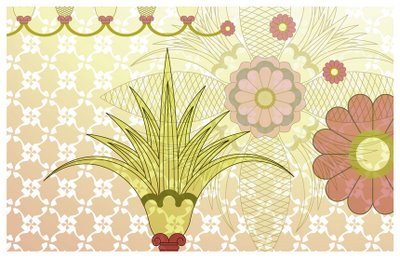 (AINA) -- Artists of non-dominant cultures have an inherent responsibility to communicate a message that is genuinely personal yet able to transcend multilayered boundaries of identity. Being Assyrian, or a displaced person in the global world, I have strengthened my ability to examine, imagine, author, create, and produce art and tell stories through my visual explorations. My native language is the basis for all of my expression, yet as a person of a culture without a country, I am free to go beyond borders and artificial constructs.
(AINA) -- Artists of non-dominant cultures have an inherent responsibility to communicate a message that is genuinely personal yet able to transcend multilayered boundaries of identity. Being Assyrian, or a displaced person in the global world, I have strengthened my ability to examine, imagine, author, create, and produce art and tell stories through my visual explorations. My native language is the basis for all of my expression, yet as a person of a culture without a country, I am free to go beyond borders and artificial constructs.
Graphic Design is a form of visual art that is concerned with the presentation and management of image and text as well as their relationships. Its primary function is to communicate by creating either a visceral reaction or to initiate an intellectual decoding process or both. The form of the neo-Assyrian alphabet, specifically Eastern Syriac letterforms, has a unique affect on my design sensibilities, as they are the core foundation of my semiotic coding of meaning. Assyrian is my mother's language; what I heard in relation to what I saw visually and what I first coded and decoded, gives meaning to the world around me. I have chosen to examine the semiotics of this letterform along side ancient Assyrian patterns, by constructing and deconstructing their form. Through this investigation, the subject matter spans 20th Century Assyrian history, depicting an autobiographical connection to the subject.
Several unique observations have arisen, both visually and conceptually, through this investigation. The relationship of patterns and ornamentation is juxtaposed with abstract form and documentary content. Formation of a cluster of letterforms transform into a variegated visual repetition of patterns, utilizing historic and contemporary photos and text to document a specific aspect of 20th Century Assyrian history.
By cropping the form of each letter to its basic identifying feature, our relationship to letterforms is also distilled to its essence. Photographic scans are manipulated, including my childhood Assyrian notebook, along with Persian and English writing, examining their relationships, as a vehicle for learning my mother's language, and symbolism of the letterforms. This abstraction of code allows for transcending the subjective where both Assyrian and non-Assyrian viewers can share in a profound and familiar experience; the development of an identity through language, form and culture.
Assyrian letters function as a visual tool through which I can express my design sensibility. The form of the letter holds who we are as Assyrians. Nothing can threaten the existence of this culture so long as the language remains. Despite all of the language deterioration, it is the alphabet, as the form of the language, which gives us our identity.
By Sharokin Betgevargiz
Sharokin Betgevargiz is an MFA candidate in graphic design at Boston University.
Boston University's College of Fine Arts is hosting the 2006 Graduate MFA Exhibitions. Sharokin Betgevargiz, a MFA candidate at the School of Visual Arts, will showcase her thesis designs at the Graphic Design Exhibition.
Using modern Assyrian letterforms and ancient Assyrian patterns, she weaves a variegated visual repetition and multilayered connection of a fragile but resilient identity that spans from Ancient Mesopotamia to current day Iraq and the forced Arabization and Kurdification of Assyrians in the region.
Reception
Thursday, April 20, 6:00-8:00pm
Drinks and food will be provided.
Boston University Art Gallery
College of Fine Arts
First Floor
855 Commonwealth Avenue, Boston
Gallery Hours
Tuesday--Friday, 10am--5pm
Saturday & Sunday, 1--5pm
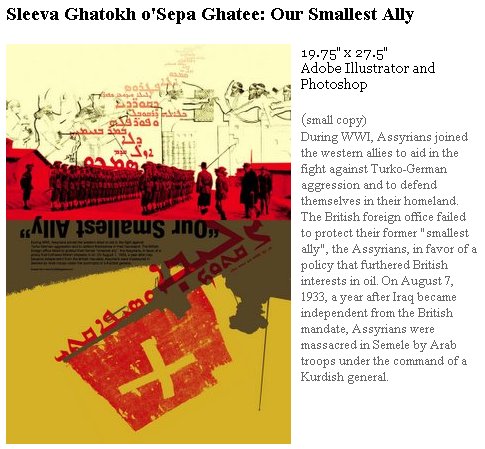
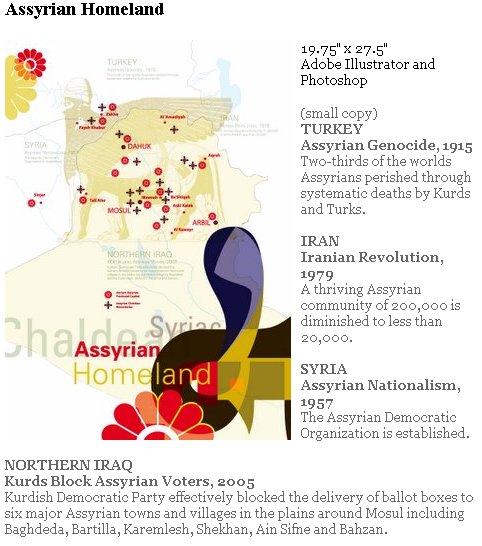
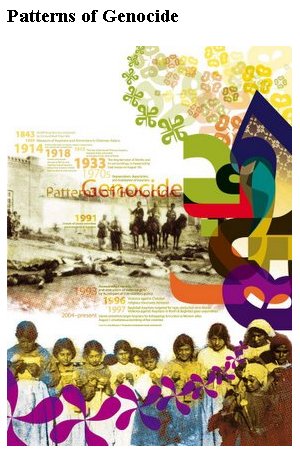
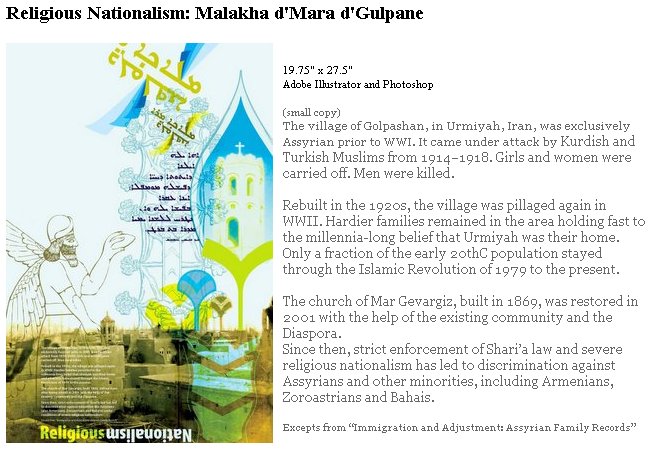
 Out of order, cropped and displaced, this piece examines the relationship of Assyrians with their Aramaic language, a relationship distinguished by a rich ancient history, a medieval Christain Syriac heritage, cultural values and customs, as well as survival from genocide, upheaval, assimilation, and current political and religious struggles in our homeland, Iraq.
Out of order, cropped and displaced, this piece examines the relationship of Assyrians with their Aramaic language, a relationship distinguished by a rich ancient history, a medieval Christain Syriac heritage, cultural values and customs, as well as survival from genocide, upheaval, assimilation, and current political and religious struggles in our homeland, Iraq.
Each letterform is cropped to examine our memory for a distinct visual form, the letters unique identifying factor. The juxtaposition of letters in the checkerboard enhances but also confuses our recognition of the letter. As we strive to recognize our letters, we strengthen our ties to our mothertongue despite the attractions of assimilation and the punishments of dispersal.
The oldest continuously written and spoken language of the Middle East is in disarray, almost lost.
25 years later, I dug out my Assyrian language notebooks. Was that really how well I wrote, I was barely a teen! Today, I seldom dream in Assyrian.
In the last page of my Assyrian notebook, I come across English sentences, with the mention of the work "Allah" reminding me of the Islamic Revolution. I placed that atop of a visual arrow facing forward, as "In the name of God", was placed on all letterhead.
Another note page in the middle is a verb conjugation in Assyrian, with instruction of grammar taught in Persian, learning the grammar of my mother's language by detailed instruction in Persian. The third page is an essay I wrote to an assigned topic "If someday we loose our language as we've lost everything, what would happen?", placed in the bottom as we struggle to remember reading our mother's language.
Black and dark grays symbolize our hearts, are sorrowfully longing for recognition. The colors selected are blue, yellow and red for their primary values, magenta and purple as active secondary colors. These basic colors symbolize our inherent relation to our language and the active colors target our youth. Together shaping of a forward moving arrow (left directional), as the direction of our writing, I hope to move forward against the dark pallate of our collective struggle.

or register to post a comment.